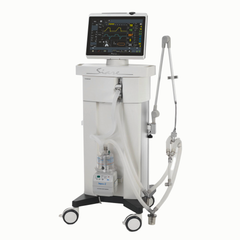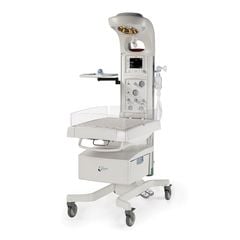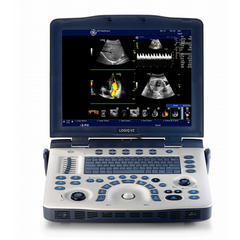GE Vivid S70 FAQs:
Auto Optimization is a one-touch image optimization function that a user uses to optimize the image, based on the actual B-mode image or Pulse wave Doppler data. The function works based on preset levels (Low, Medium, and High) and allows users to pick a preference for the contrast enhancement in the resulting image. Low does the least amount of contrast enhancement, high does the most. Auto Optimization is available in single or multi image, on live, frozen or CINE images (in B-Mode only), while in zoom, and in Spectral Doppler. Auto Optimization in PW Doppler Mode optimizes the spectral data. Auto adjusts the Velocity Scale (live imaging only), baseline shift, dynamic range, and invert (if preset). Upon deactivation, the spectrum is still optimized.
B-Flow utilizes gray scale imaging to visualize a blood flow with different gray intensities according to the reflectors speed and hemodynamics. B-Flow is less dependent on the user or scanning angle, while Color Doppler is heavily dependent on the scanning angle. It also provides higher frame rate and spatial resolution than Color Flow. B-Flow may help visualize vessel-wall irregularities, kidney perfusion, liver and spleen vasculature, and bladder reflux or jets.
Anatomical M-Mode helps improve accuracy of arrhythmia assessments and cardiac measurements. It enables to provide M Mode images truly perpendicular to ventricular septum.
Virtual Apex provides wider FOV in the nearfield. Available on sector probes.
Raw Data is a software tool that enables image processing, quick data re-acquisition, and image analysis with same resolution and same frame rates of original images. Raw Data shortens exam duration, improves clinical workflow by post-processing, and reduces a time to put the probe on a patient.
Matrix Array Volume Technology is the most advanced transducer technology in the ultrasound industry. It overcomes the limitation of volume achieving rate, improves the image quality of coronal view, and enables to unlimited post processing. The matrix array has a 2-dimensional arrangement of transducer elements like squares on a chessboard. This allows control over the sound beam in two perpendicular angles. With that, one can steer and focus the sound beam on a whole volume.
Auto IMT automates measurement of intima-media thickness of vessels. Auto IMT helps keep track of atherosclerosis diseases from the early stage as it is developed.
Tissue Velocity Imaging (TVI) is a myocardial Doppler Imaging with a color overlay on the tissue image that is available on the sector probes. Tissue color overlay can be removed to show just the 2D image, while still retaining the tissue velocity information. Tissue Velocity Imaging (TVI) is an ultrasound-based technique used for quantitative analysis of the cardiac function, and has earlier been evaluated according to myocardial velocities. The technique is the same as for Doppler echocardiography, which measures flow velocities. Tissue signals, however, have higher amplitude and lower velocities, and the signals are extracted by using different filter and gain settings.
TSI (Tissue Synchronization Imaging) is a parametric imaging tool derived from Tissue Velocity Imaging (TVI), which portrays regional asynchrony on 2D echocardiographic pictures. This image is portrayed by transforming the timing of regional peak velocity during the ejection phase into color codes and overlying the moving myocardium. This allows immediate visual identification of a regional delay in systole, while a quick quantitative measurement of regional delay can be taken.
Strain and Strain Rate are for evaluation of regional myocardial function, and for assessing synchronicity and guidance during biventricular pacing procedures. Strain and Strain Rate utilizes the TVI mode. Strain calculates and color-codes the extent of tissue deformation (lengthening or shortening) relative to the original size over a given time interval, typically the systole. Strain rate calculates and color-codes the deformation per unit time i.e. the speed at which the tissue deformation occurs. Strain rate is calculated as the spatial gradient of velocity data.
Auto EF is the function that automatically measures LV ejection fraction. Along with the Automated Function Imaging (AFI) feature, Auto EF maximizes time efficiency by the reproducible quantitative output that increases the physician’s diagnostic confidence.
Automated Function Imaging (AFI) is a decision support tool for regional and global assessment of the LV systolic function. AFI is a tool derived from 2D Strain, which calculates the myocardial tissue deformation based on feature tracking on 2D grey scale loops.
Left Ventricular Contrast imaging: The LV Contrast and LVO Stress applications are optimized for endocardial border detection and assessment of wall motion and wall thickening.
Contrast Low MI: enables real-time imaging, using a MI low enough to generate little tissue signal whilst generating sufficient signal from microbubbles. This allows continuous imaging as the low MI avoids significant bubble destruction. A flash of high MI ultrasound pulses can intentionally destroy microbubbles, while, contrast replenishment is then observed to allow qualitative and quantitative assessment of the myocardium utilizing a contrast agent.
4D Auto LVQ (Automated Left Ventricular Quantification) tool enables the estimation of the left ventricular volumes and the ejection fraction in 4D data sets based on automatic border detection. The tool also enables estimation of left ventricular mass and strain (only with transthoracic 4D acquisitions). The automatic border detection is created after placing two points in an end-diastolic apical view: one at the center of the LV base and one at the apex.
4D Mitral Valve Assessment is the semi-automated MV assessment tool from Tomtec that provides the ability to include quantitative results for the mitral valve apparatus, into the patient’s exam. 4D MV-Assessment only works on stored patient data. It does not work on images that were just acquired and not yet stored.
Quantitative analysis (Q Analysis) software package is designed for analysis of TVI related (Tissue Tracking, Strain, Strain rate, TSI) and Contrast related raw data. Q Analysis traces for velocity or derived Parameters inside defined regions of interest as function of time.
Read more: https://www.gehealthcare.com/products/ultrasound/vivid/vivid-s70n




